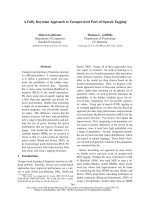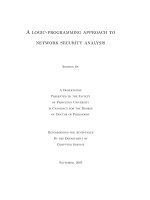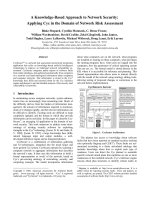A representation theoretic approach to an eisenstein series
Bạn đang xem bản rút gọn của tài liệu. Xem và tải ngay bản đầy đủ của tài liệu tại đây (334.39 KB, 41 trang )
A REPRESENTATION-
THEORETIC APPROACH
TO AN EISENSTEIN SERIES
by
AI XINGHUAN
B.Sc (Hons), NUS
A THESIS SUBMITTED
FOR THE DEGREE OF MASTER OF SCIENCE
DEPARTMENT OF MATHEMATICS
FACULTY OF SCIENCE
NATIONAL UNIVERSITY OF SINGAPORE
2010
i
Summary
In [1], the authors have developed a representation-theoretic ap-
proach to reveal the correspondence between certain automorphic
representation and Kohnen’s plus space. Though the quoted arti-
cle focuses on cusp forms, the methodology applies to a larger au-
dience, including the Eisenstein series of half-integral weight. The
current writing will carry out this approach, with necessary ad-
justments, to establish a similar link between certain induced rep-
resentation and the Eisenstein series H
r/2
of half-integral weight.
ii
Acknowledgements
I would to express my thanks and appreciation to Associate Pro-
fessor LOKE Hung Yean, for his academic guidance and patience;
Prof ZHU Cheng Bo, Prof LEE Soo Teck, Mr. TANG U-Liang for
their kindness to answer to my questions; last but not least, my
parents and friends who have been encouraging and supporting
me during my graduate study.
Contents
1 Number-Theoretic Approach to H
r/2
1
1.1 Modular Forms . . . . . . . . . . . . . . . . . . . . . . . . . . 1
1.1.1 Modular group and congruence subgroups . . . . . . . 1
1.1.2 Modular functions and modular forms . . . . . . . . . 2
1.1.3 Eisenstein series . . . . . . . . . . . . . . . . . . . . . . 3
1.1.4 Slash operator . . . . . . . . . . . . . . . . . . . . . . . 4
1.1.5 Double coset and Hecke operator . . . . . . . . . . . . 5
1.2 Modular Forms of Half-Integral Weight . . . . . . . . . . . . . 7
1.2.1 Modular form of weight r/2 . . . . . . . . . . . . . . . 7
1.2.2 A 4-sheeted covering of GL
+
2
(Q) . . . . . . . . . . . . . 8
1.2.3 Eisenstein series . . . . . . . . . . . . . . . . . . . . . . 10
1.2.4 Hecke operators on forms of half-integral weight . . . . 11
1.2.5 The Shimura map . . . . . . . . . . . . . . . . . . . . . 12
1.2.6 Kohnen’s plus space . . . . . . . . . . . . . . . . . . . 13
2 Representation-theoretic approach to H
r/2
15
2.1 Induction over Adele . . . . . . . . . . . . . . . . . . . . . . . 16
2.2 Inductions over local fields . . . . . . . . . . . . . . . . . . . . 20
2.3 Main Theorem . . . . . . . . . . . . . . . . . . . . . . . . . . 25
2.4 Proof . . . . . . . . . . . . . . . . . . . . . . . . . . . . . . . . 27
iii
iv CONTENTS
Chapter 1
Number-Theoretic Approach to
H
r/2
In this chapter, we introduce the basic notion of modular forms and related
concepts. The Hecke eigenform H
r/2
will be discussed in its number-theoretic
background. The main references are [2], [3].
1.1 Modular Forms
1.1.1 Modular group and congruence subgroups
Let H = {z|Im(z) > 0} be the upper half plane of C. The special linear
group SL
2
(Z) acts on H by linear fractional transformation, i.e. for all γ =
a b
c d
∈ SL
2
(Z), z ∈ H, we define γ · z =
az+b
cz+d
. Let Γ be a subgroup of
1
2 1. NUMBER-THEORETIC APPROACH TO H
R/2
SL
2
(Z) of finite index, then Γ is called a congruence subgroup if it contains
Γ(N) =
a b
c d
∈ SL
2
(Z)
a b
c d
≡
1 0
0 1
(mod N)
for some positive integer N. For our purpose, the following two congruence
subgroups are the most important. Namely,
Γ
0
(N) =
a b
c d
∈ SL
2
(Z)
c ≡ 0 (mod N)
and
Γ
1
(N) =
a b
c d
∈ SL
2
(Z)
a b
c d
≡
1 ∗
0 1
(mod N)
.
1.1.2 Modular functions and modular forms
Let k be an integer. A complex-valued function f on H is weakly modular of
weight 2k if f is meromorphic on H and satisfies the relation:
f(z) = (cz + d)
−2k
f(
az + b
cz + d
)
1.1. MODULAR FORMS 3
for all
a b
c d
∈ SL
2
(Z). A meromorphic function is weakly modular of
weight 2k if and only if
f(z + 1) = f(z) and f(−
1
z
) = z
2k
f(z).
In particular, since f has period 1, we can rename f to
˜
f as a function of
q = e
2πiz
. Then f(z) =
˜
f(q) =
+∞
−∞
a
n
q
n
. A weakly modular function f is
called modular if it is meromorphic at infinity, which means that
˜
f extends to
a meromorphic function at the origin. A modular function is called a modular
form if it is holomorphic everywhere, including at infinity. This means that
a
n
are zero for all n smaller than a certain integer. Furthermore, if a modular
form is zero at infinity, it is called a cusp form. Here “holomorphic at infinity”
means a
n
are zero for n < 0 and “zero at infinity” means a
n
are zero for n ≤ 0.
1.1.3 Eisenstein series
For any integer k greater than 1, an Eisenstein series of weight 2k is defined
as follows
G
k
(z) =
m,n
1
(mz + n)
2k
where the summation is over all pairs of integers (m, n) other than (0, 0). The
Eisenstein series G
k
(z) is a modular form of weight 2k. We have G
k
(∞) =
2ζ(2k) where ζ denotes the Riemann zeta function.
4 1. NUMBER-THEORETIC APPROACH TO H
R/2
Denote by M
k
the C-vector space of modular forms of weight 2k, M
0
k
the
C-vector space of cusp forms of weight 2k. Then dim(M
k
/M
0
k
) ≤ 1. In fact,
M
k
= M
0
k
⊕ CG
k
for k ≥ 2. When k = 0, 2, 3, 4, 5, M
k
is a vector space of dimension 1
with basis 1, G
2
, G
3
, G
4
, G
5
respectively, and of course, M
0
k
= 0 for these
values of k. Denote g
2
= 60G
2
, and g
3
= 140G
3
. Let ∆ = g
3
2
− 27g
2
3
, then
multiplication by ∆ defines an isomorphism from M
k−6
onto M
0
k
.
1.1.4 Slash operator
Let GL
+
2
(Q) denote the subgroup of GL
2
(Q) consisting of matrices with
positive determinant. Suppose f is a modular form of weight 2k. We define
a “slash operator |[γ]
2k
” as follows,
(f|[γ]
2k
)(z) = (det γ)
k
(cz + d)
−2k
f(γz)
where γ =
a b
c d
∈ GL
+
2
(Q). It can be verified that (f|[γ
1
]
2k
)|[γ
2
]
2k
=
f|[γ
1
γ
2
]
2k
, for γ
1
, γ
2
∈ GL
+
2
(Q)]. See [2]
1.1. MODULAR FORMS 5
1.1.5 Double coset and Hecke operator
Let ∆ be any subgroup of any group G, and let ξ ∈ G be any element of
G such that ∆ and ξ
−1
∆ξ are commensurable, i.e., their intersection ∆
=
∆ ∩ ξ
−1
∆ξ is of finite index in either group. Let [∆ : ∆
] = d and write
∆ = ∪
d
j=1
∆
δ
j
, where δ
j
∈ ∆. Then ∆ξ∆ = ∪
d
j=1
∆ξδ
j
.
Suppose that Γ is a congruence subgroup of SL
2
(Z), and let α ∈ GL
+
2
(Q).
Denote Γ
= Γ ∩ α
−1
Γα, d = [Γ : Γ
], and Γ = ∪
d
j=1
Γ
γ
j
. Suppose that f(z)
is a function invariant under |[γ]
2k
for all γ ∈ Γ. Then we may define the
action of the double coset ΓαΓ on f by
(f|[ΓαΓ]
2k
)(z) =
d
j=1
(f|[αγ
j
]
2k
)(z).
Let Γ = Γ
1
(N), and let n be a positive integer. Denote by ∆ the set of
integer matrices of determinant n which are congruent to
1 ∗
0 n
modulo
N. Then we define Hecke operator T
n
on a modular form f ∈ M
k
(Γ
1
(N)) by
T
n
(f) = n
k−1
f|[Γ
1
(N)αΓ
1
(N)]
2k
,
where the sum runs over all double cosets of Γ
1
(N) in ∆. If n is squarefree,
there is only one double coset of Γ
1
(N) in ∆.
It follows that if (m, n) = 1, T
m
and T
n
commute and for prime number
6 1. NUMBER-THEORETIC APPROACH TO H
R/2
p and positive integer n, we have
T
p
T
p
n
= T
p
n+1
+ p
2k−1
T
p
n−1
.
1.2. MODULAR FORMS OF HALF-INTEGRAL WEIGHT 7
1.2 Modular Forms of Half-Integral Weight
1.2.1 Modular form of weight r/2
It may be verified easily that
Lemma. For any odd integer r, if f(γz) = (cz + d)
r/2
f(z), then f(z) = 0.
So we need an alternative way to define the modular forms of half-integral
weight. We first introduce the following notations.
Let d be an odd integer, let c be any integer. If d is a positive prime
number, the usual quadratic residue symbol (
c
d
) is defined as
c
d
=
1 if c is a nonzero quadratic residue modulo d
0 if d|c
−1 otherwise
We extend this definition to arbitrary odd d as follows. Suppose d can be
written as a product of primes d =
j
p
j
, where p
j
are not necessarily dis-
tinct. Define (
c
d
) =
j
(
c
p
j
). If (c, d) > 1, then (
c
d
) = 0. If d = ±1 and c = 0,
then (
c
d
) = 1. If d < 0, c > 0, then (
c
d
) = (
c
|d|
). Finally, if d < 0, c < 0, then
(
c
d
) = −(
c
|d|
). This extended definition is also used in the second chapter.
For the multi-valued function z
1
2
, z ∈ C, we always take the branch of
the square root with argument in (−
π
2
,
π
2
].
8 1. NUMBER-THEORETIC APPROACH TO H
R/2
For an odd integer d, we define
d
=
1 if d ≡ 1 (mod 4)
i if d ≡ 3 (mod 4)
Now we may define the automorphy factor j(γ, z) for γ =
a b
c d
∈ Γ
0
(4)
and z ∈ H by
j(γ, z) = (
c
d
)
−1
d
(cz + d)
1
2
.
Let k be an odd integer, a holomorphic function f on H is called a modular
form of weight
r
2
if, for γ =
a b
c d
∈ Γ
0
(4) and z ∈ H,
f(γz) = (j(γ, z))
r
f(z).
1.2.2 A 4-sheeted covering of GL
+
2
(Q)
Since the automorphy factor j(γ, z) is only defined for γ ∈ Γ
0
(4), we do not
have a preferred branch of the square root (cz + d)
1
2
for an arbitrary element
in GL
+
2
(Q). Instead of GL
+
2
(Q), we shall need a four-sheeted covering G,
which is sufficiently large to handle all possible branches of the square roots
occurring in the automorphy factor j(γ, z). Let T denote the group of the
fourth roots of unity. Define G to be the set of all ordered pairs (α, φ(z)),
1.2. MODULAR FORMS OF HALF-INTEGRAL WEIGHT 9
where α =
a b
c d
∈ GL
+
2
(Q), φ(z) is a holomorphic function on H such
that φ(z)
2
= t
cz+d
√
det α
for some t ∈ {±1}. The group law of G is guaranteed
by the following proposition from [2].
Proposition. Suppose (α, φ(z)), (β, ψ(z)) are two elements of G, then the
product
(α, φ(z))(β, ψ(z)) = (αβ, φ(βz)ψ(z))
defines a group law of G.
Now, for any congruence subgroup Γ, we denote by
Γ the subgroup
{(γ, j(γ, z)|γ ∈ Γ} of G.
For ξ = (α, φ(z)) ∈ G and r ∈ Z, we define a “slash operator” |[ξ]
r/2
on
functions f defined on H by
(f|[ξ]
r/2
)(z) = f(αz)φ(z)
−r
.
We may now proceed to define the space of modular forms on the liftings
of congruence subgroups.
Suppose f(z) is a meromorphic function on H, and invariant under [γ]
r/2
for γ in a subgroup Γ
of finite index in Γ
0
(4). It is shown in [2] that such f
admits a q
h
expansion similar to that of integral weight modular forms, where
q
h
= e
2πiz/h
for some integer h. In the same fashion, we say f is meromorphic
at infinity if only finitely many negative powers of q
h
occur in the expansion,
10 1. NUMBER-THEORETIC APPROACH TO H
R/2
and holomorphic if no negative powers of q
h
occur.
Consider the action of elements in Γ
on the cusps Q∪∞. Proposition 2 in
chapter 4 section 1 of [2] implies that the above definitions of meromorphic or
holomorphic functions depends only on the Γ
-equivalence class of the cusps.
We say that f(z) is a modular form (cusp form) of weight r/2 for
Γ
if it is
meromorphic (holomorphic) at every cusp of Γ
. We denote by M
r/2
(
Γ
) the
space of modular forms of weight r/2 for
Γ
and S
r/2
(
Γ
) the space of cusp
forms of weight r/2 for
Γ
.
1.2.3 Eisenstein series
Let r be an odd integer, r ≥ 5. An Eisenstein series E
r/2
of weight r/2 is
defined as
E
r/2
(z) =
γ∈Γ
∞
\Γ
0
(4)
j(γ, z)
−r
.
Also, we define another Eisenstein series F
r/2
of weight r/2 by
F
r/2
= E
r/2
0 −1
4 0
,
√
2z
r/2
.
They both belong to M
r/2
(
Γ
0
(4)) and are linearly independent. In fact, they
span the subspace of non-cusp forms. Alternatively, E
r/2
and F
r/2
can be
1.2. MODULAR FORMS OF HALF-INTEGRAL WEIGHT 11
presented as follows.
E
r/2
=
4|c,d>0
(c,d)=1
c
d
r
d
(cz + d)
−r/2
,
F
r/2
= 2
−r/2
(c,d)=1,d>0
d is odd
−c
d
r
d
(dz + c)
−r/2
.
In particular, we are interested in a linear combination of the two Eisenstein
series,
H
r/2
= ζ(1 − 2λ)(E
r/2
+ (1 + i
r
)2
r/2
F
r/2
),
where λ = (r − 1)/2. Its q-expansion coefficients enjoy nice properties, but
implication of these exhibits only in the context of the theory of elliptic
curves, so we pause here.
1.2.4 Hecke operators on forms of half-integral weight
Denote
ξ
n
=
1 0
0 n
, n
1/4
.
Suppose 4|N, define
T
n
f = f|[
Γ
1
(N)ξ
n
Γ
1
(N)]
r/2
=
j
f|[ξ
n
γ
j
]
r/2
,
12 1. NUMBER-THEORETIC APPROACH TO H
R/2
where the sum is over all distinct right cosets of
Γ
1
(N) in the double coset.
It is known that the Hecke operators on forms of half-integral weight are
nontrivial only for perfect square n.
1.2.5 The Shimura map
For each positive squarefree integer, Shimura and Niwa constructed a lifting
of cusp forms of weight r/2 for Γ
0
(4N) with character χ to cusp forms of
weight r −1 for Γ
0
(2N) with character χ
2
, where r ≥ 7. [2][6]
Theorem. (Shimura) Let r ≥ 3 be an odd integer, λ = (r−1)/2, 4|N, χ be a
Dirichlet character modulo N. Let f(z) =
∞
n=1
a
n
e
2πinz
∈ S
r/2
(
Γ
0
(N), χ) be
an eigenform for T
p
2
for all primes p with corresponding eigenvalue λ
p
, i.e.,
T
p
2
(f) = λ
p
f. Define a function g(z) =
∞
n=1
b
n
e
2πinz
where b
n
are given by
the following identity.
∞
n=1
b
n
n
−s
=
all p
1
1 −λ
p
p
−s
+ χ
2
(p)p
r−2−2s
.
Then g ∈ M
r−1
(N
, χ
2
) for some integer N
which is divisible by the conductor
of χ
2
. If r ≥ 5, then g is a cusp form.
Proposition. (Niwa) In Theorem 1.2.5 one can always take N
= N/2.
The reuslts above are stated in their full generality. However, we are only
interested in the simplest case when N equals to 4 and χ is trivial. Then the
theorem works for f(z) ∈ S
r/2
(
Γ
0
(4)).
1.2. MODULAR FORMS OF HALF-INTEGRAL WEIGHT 13
1.2.6 Kohnen’s plus space
Denote
M
+
r/2
(
Γ
0
(4)) =
f ∈ M
r/2
(
Γ
0
(4))
f(z) =
a
n
q
n
,
a
n
= 0 when (−1)
(r−1)/2
n ≡ 2 or 3(mod 4)
It turns out that M
+
r/2
(
Γ
0
(4)) is the direct sum of a 1-dimensional subspace
spanned by H
r/2
and the following subspace of cusp forms,
S
+
r/2
(
Γ
0
(4)) =
f ∈ S
r/2
(
Γ
0
(4))
f(z) =
a
n
q
n
,
a
n
= 0 when (−1)
(r−1)/2
n ≡ 2 or 3(mod 4)
In [4], Kohnen showed that under the above Shimura map we have isomor-
phisms from M
+
r/2
(
Γ
0
(4)) to M
r−1
(SL
2
(Z)) and from S
+
r/2
(
Γ
0
(4)) to S
r−1
(SL
2
(Z)).
Kohnen has also modified the Hecke operator T
4
, and defined a slightly
different operator T
+
4
on M
+
r/2
(
Γ
0
(4)), then proved that H
r/2
is a Hecke eigen-
form for the operator T
+
4
.
14 1. NUMBER-THEORETIC APPROACH TO H
R/2
Chapter 2
Representation-theoretic
approach to H
r/2
Gelbart showed in [5] that there is a bijection mapping between certain au-
tomorphic representation and the space of cusp forms of half-integral weight.
Then in [1] one result is that a subspace of the automorphic functions corre-
sponds to Kohnen’s plus space of cusp forms under the same bijection coupled
with an operator introduced in [6]. The objective of the current chapter is
to show that, under the representation-theoretic methodology outlined by [5]
and [1], we can construct in certain induced representation a function that
corresponds to the Hecke eigenform H
r/2
.
The underlying field F is either Q
p
or R.
15
16 2. REPRESENTATION-THEORETIC APPROACH TO H
R/2
2.1 Induction over Adele
Now, with the help of the Weil index, we construct an induced representation
over the Adele A(Q).
Let
G(A) = SL
2
(A), T =
t 0
0 t
−1
∈ G(A)
, B =
a b
0 a
−1
∈ G(A)
,
and
K
p
= SL
2
(Z
p
), K
∞
= SO
2
(R), K = K
∞
·
p
K
p
.
As sets, denote
G(A) = G(A) ×{±1}, T(A) = T(A) × {±1}, B(A) = B(A) × {±1}.
We equip G(A) with the group law in the proposition 2.6 of [5]. Namely, at
place p, the group law on G(Q
p
) is
(g
1
,
1
)(g
2
,
2
) = (g
1
g
2
,
1
2
σ
p
(g
1
, g
2
)),
where σ
p
(g
1
, g
2
) is a 2-cocycle defined as follows. Let (∗, ∗)
p
be the Hilbert
2.1. INDUCTION OVER ADELE 17
symbol over Q
p
. For all g
p
=
a b
c d
∈ G(Q
p
), define
x
p
(g
p
) =
c if c = 0,
d if c = 0,
and
s
p
(g
p
) =
(c, d)
p
if p is a finite prime, cd = 0 and ord(c) is odd,
1 otherwise.
Then
σ
p
(g
1
, g
2
) = (x
p
(g
1
g
2
)x
p
(g
1
), x
p
(g
1
g
2
)x
p
(g
2
))
p
s
p
(g
1
)s
p
(g
2
)s
p
(g
1
g
2
).
Define σ
A
=
p<∞
σ
p
so that the group law on G(A) is
(g
1
,
1
)(g
2
,
2
) = (g
1
g
2
,
1
2
σ
A
(g
1
, g
2
)).
Define s
A
=
p<∞
s
p
. By proposition 2.15 of [5], the map
γ → (γ, s
A
(γ))
provides an isomorphism between G(Q) and a subgroup of G(A). Thus we
may denote an arbitrary element of G(A) in the form (x, s
A
(x)) henceforth.
18 2. REPRESENTATION-THEORETIC APPROACH TO H
R/2
For all s ∈ C, we define the characters
χ
s
: T(Q)\T(A) → C
×
χ
s
t 0
0 t
−1
= |t|
s+1
=
|t
∞
|
∞
p
|t
p
|
p
s+1
,
where t
∞
∈ R, t
p
∈ Q
p
, and |·|
∞
, | · |
p
are norms of R, Q
p
respectively. Note
that χ
s
(t) = 1 if t ∈ ∆Q, the diagonal embedding of Q into A.
Since SL
2
(A) admits Iwasawa decomposition, we may extend the defini-
tion of χ
s
to SL
2
(A) by
χ
s
(ntk) = χ
s
(t),
where n ∈ N(A) =
1 b
0 1
b ∈ A
, t ∈ T(A), k ∈ K(A).
Let F denote the space of C
∞
-functions f on G(A) s.t.
i) The right translates of f by K
∞
K
2
span a finite dimensional subspace;
ii) f(ubtg) = γ(t)f(g), ∀u ∈ N(A), b ∈ B(Q), t ∈ T(A), g ∈ G(A), where
γ(t) = γ(t
∞
) ·
γ
p
(t
p
) is the Weil character defined in [7].
Let
I(s) =
χ
s
f
f ∈ F, f(tng) = χ
s
(t)f(g),
∀t ∈ T(A), n ∈ N(A), g ∈ G(A)
.
Then I(s) is an induced representation of G(A) by right translation.
2.1. INDUCTION OVER ADELE 19
For ϕ ∈ I(s), we define
E(g, s, ϕ) =
x∈∆B(Q)\G(Q)
ϕ((x, s
A
(x))g)χ
s
(xg)
The sum converges absolutely and uniformly for g in any compact subset and
s with Re(s) > 1. [8] This is a function on SL
2
(Q)\G(A).
20 2. REPRESENTATION-THEORETIC APPROACH TO H
R/2
2.2 Inductions over local fields
Now we develop the theory for local places, namely, for
SL
2
(Q
p
), where p is
prime, and
SL
2
(R).
In light of Iwasawa decomposition for
SL
2
(A), we denote
B =
∗ ∗
0 ∗
,
B =
∗ ∗
0 ∗
, ±1
;
T =
∗ 0
0 ∗
,
T =
∗ 0
0 ∗
, ±1
;
N =
1 ∗
0 1
,
N =
1 ∗
0 1
, 1
,
where ∗ is an arbitrary element in the underlying field (or ring). With these
notations, we only specify the underlying fields when necessary. Now we have
B =
T
N ⊆
SL
2
. In particular,
B,
T , and
N are subgroups of
SL
2
.
Let
K =
SL
2
(Z
p
) ×{±1} if F = Q
p
SO
2
(R) ×{±1} if F = R









